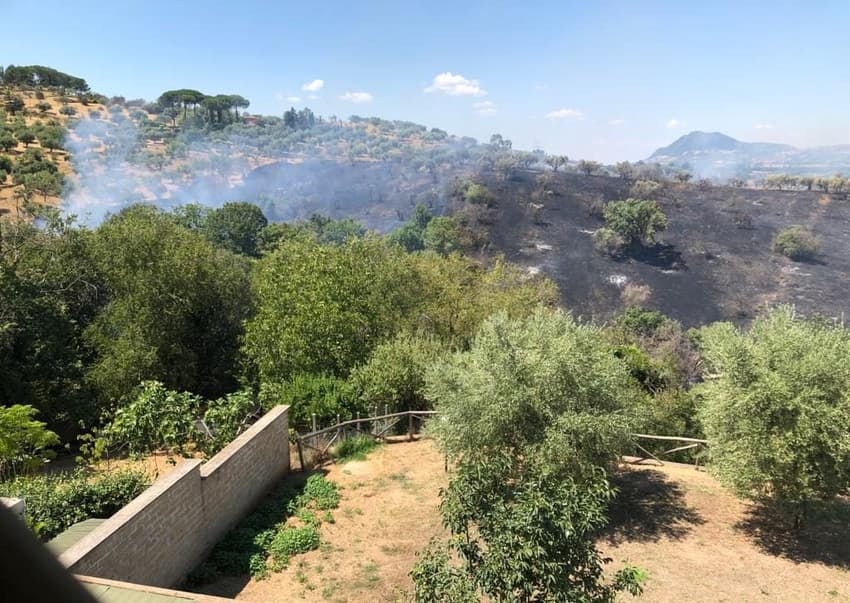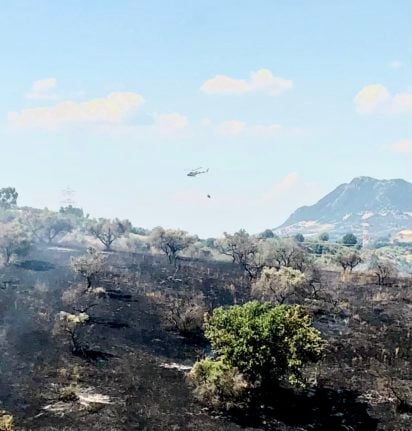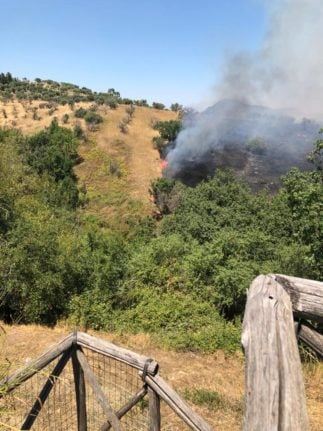OPINION: Italy is burning - but many wildfires could be prevented

After her own home was threatened by wildfires this week, reporter Silvia Marchetti says more could be done to stop the inferno that ravages Italy every summer.
I live in the countryside north of Rome and it’s been burning with wildfires for the past three days.
The flames have destroyed beautiful, ancient olive groves and vineyards. Hillsides are scorched, roofs are covered in soot, and firefighters’ helicopters carrying water come and go. I open my window and I see a black wasteland. The toxic smell of smoke fills the air.
READ ALSO: Where are wildfires raging in Italy?
Every summer it’s always the same nightmare, but this year is worse. It's a scorching hot July and many areas across the whole of Italy - rural and urban - are burning.
In the first seven months of this year there have been 346.000 wildfires, more than in the same period in 2021, according to farmers' lobby Coldiretti.
There’s a mix of factors at play: natural causes (climate change, higher temperatures, drier land) and direct human causes such as arson - a crime which is worsened, and heightened, by Italy’s unapplied rules and fines.
 A fire and rescue helicopter works to put out a wildfire near the author's home. Photo: Silvia Marchetti
A fire and rescue helicopter works to put out a wildfire near the author's home. Photo: Silvia Marchetti
A report by environmental group Legambiente suggests roughly 62.000 hectares of land burnt in 2020 due to arson and mafia-linked motives, such as making room for new buildings and other profit-seeking purposes, particularly in the southern regions.
Meanwhile the civil protection agency says just two percent of Italy’s wildfires have natural causes.
The problem is pretty much the same around the country: rising temperatures, combined with illicit human acts, cause wildfires to multiply.
READ ALSO: Italian wildfires ‘three times worse’ than average this year as heatwave continues
Farmers themselves may burn their own estates - or malicious neighbours do so to destroy their profits. Some farmers don’t maintain fields properly, they don’t cut the grass ahead of summer, then when the heat comes and it doesn’t rain, the land is all dried out and ready to light up like a match.
In December I’ve seen the owners of the estate in front of my house, which regularly catches on fire in summer, organizing picnics and olive harvests, but never once did they cut the grass or trim the trees.
Last summer a wildfire destroyed their centuries-old olive trees. It took 11 months for the scorched black soil to turn green again, and now, exactly one year later, we’re back to square one: burnt to ashes.
Firefighters I spoke to over the weekend said they can tell natural wildfires from those caused by arson: it seems they’re able to find some kind of ‘artificial’ match that triggered the blaze, like small heaps of dry grass placed in strategic spots.
READ ALSO: What to do and what to avoid if you see a wildfire in Italy
There are rules, backed up by fines, which require farmers to maintain their property for safety and environmental reasons, and rules that forbid building on burnt land for 15 years. But local authorities don’t follow up on checks, and rarely enforce the law, at least where I live.
Winter season should be used to prepare rural estates for the hot months, though this seldom happens. It’s no secret that burnt land is more fertile and yields more succulent olive oil, fruit and vegetables.
On Saturday a wildfire on the hill opposite my house almost reached my property. I could see the flames licking their way up the forest path leading to the garden.
The crackling noise of burning tree wood as the fire spreads is frightening. It all happened extremely quickly; in less than 10 minutes the smoke turned to fire.

Flames rise as farmland catches fire near the author's home. Photo: Silvia Marchetti
I called the firefighters and by the time they got to my place, after an hour, the whole valley was black and flames were everywhere, clouds of smoke in the sky. They had to work for six hours to extinguish it. I was about to jump in the car and abandon my house, for I could see flames approaching. The lady next door became ill, and an ambulance was called - but it never arrived because the driver couldn’t find the address.
Firefighters do a great job and risk their lives every day, but could more be done to cut reaction time by pre-mapping risky areas?
These tend to be always the same, ‘critical’ ones. Each summer, at least in rural zones, it’s specific, well-known valleys, orchards and estates that burn to ashes.
Could authorities place some kind of ‘early warning detectors’ in risky spots that pick up signs of smoke before it turns into wild flames? It might be a first step to averting the spread of wildfires.
The same type of prevention strategy could also be applied to monitoring avalanches, which are becoming more frequent and have already caused many deaths in the past month.
Authorities should map potentially dangerous mountain slopes where snow and glaciers are melting, based on temperature tracking, and ban hikers from venturing there in the first place.
I believe all of these tragedies (yes, a wildfire is a tragedy even when nobody dies) come down to human causes. When the fire ‘naturally’ starts it is due to extremely hot temperatures linked to climate change.
Given that we created this scorching inferno, we’re the only ones who can stop it - or at the very least, tame it. Though it may be indeed too late.
Comments
See Also
I live in the countryside north of Rome and it’s been burning with wildfires for the past three days.
The flames have destroyed beautiful, ancient olive groves and vineyards. Hillsides are scorched, roofs are covered in soot, and firefighters’ helicopters carrying water come and go. I open my window and I see a black wasteland. The toxic smell of smoke fills the air.
READ ALSO: Where are wildfires raging in Italy?
Every summer it’s always the same nightmare, but this year is worse. It's a scorching hot July and many areas across the whole of Italy - rural and urban - are burning.
In the first seven months of this year there have been 346.000 wildfires, more than in the same period in 2021, according to farmers' lobby Coldiretti.
There’s a mix of factors at play: natural causes (climate change, higher temperatures, drier land) and direct human causes such as arson - a crime which is worsened, and heightened, by Italy’s unapplied rules and fines.

A report by environmental group Legambiente suggests roughly 62.000 hectares of land burnt in 2020 due to arson and mafia-linked motives, such as making room for new buildings and other profit-seeking purposes, particularly in the southern regions.
Meanwhile the civil protection agency says just two percent of Italy’s wildfires have natural causes.
The problem is pretty much the same around the country: rising temperatures, combined with illicit human acts, cause wildfires to multiply.
READ ALSO: Italian wildfires ‘three times worse’ than average this year as heatwave continues
Farmers themselves may burn their own estates - or malicious neighbours do so to destroy their profits. Some farmers don’t maintain fields properly, they don’t cut the grass ahead of summer, then when the heat comes and it doesn’t rain, the land is all dried out and ready to light up like a match.
In December I’ve seen the owners of the estate in front of my house, which regularly catches on fire in summer, organizing picnics and olive harvests, but never once did they cut the grass or trim the trees.
Last summer a wildfire destroyed their centuries-old olive trees. It took 11 months for the scorched black soil to turn green again, and now, exactly one year later, we’re back to square one: burnt to ashes.
Firefighters I spoke to over the weekend said they can tell natural wildfires from those caused by arson: it seems they’re able to find some kind of ‘artificial’ match that triggered the blaze, like small heaps of dry grass placed in strategic spots.
READ ALSO: What to do and what to avoid if you see a wildfire in Italy
There are rules, backed up by fines, which require farmers to maintain their property for safety and environmental reasons, and rules that forbid building on burnt land for 15 years. But local authorities don’t follow up on checks, and rarely enforce the law, at least where I live.
Winter season should be used to prepare rural estates for the hot months, though this seldom happens. It’s no secret that burnt land is more fertile and yields more succulent olive oil, fruit and vegetables.
On Saturday a wildfire on the hill opposite my house almost reached my property. I could see the flames licking their way up the forest path leading to the garden.
The crackling noise of burning tree wood as the fire spreads is frightening. It all happened extremely quickly; in less than 10 minutes the smoke turned to fire.

I called the firefighters and by the time they got to my place, after an hour, the whole valley was black and flames were everywhere, clouds of smoke in the sky. They had to work for six hours to extinguish it. I was about to jump in the car and abandon my house, for I could see flames approaching. The lady next door became ill, and an ambulance was called - but it never arrived because the driver couldn’t find the address.
Firefighters do a great job and risk their lives every day, but could more be done to cut reaction time by pre-mapping risky areas?
These tend to be always the same, ‘critical’ ones. Each summer, at least in rural zones, it’s specific, well-known valleys, orchards and estates that burn to ashes.
Could authorities place some kind of ‘early warning detectors’ in risky spots that pick up signs of smoke before it turns into wild flames? It might be a first step to averting the spread of wildfires.
The same type of prevention strategy could also be applied to monitoring avalanches, which are becoming more frequent and have already caused many deaths in the past month.
Authorities should map potentially dangerous mountain slopes where snow and glaciers are melting, based on temperature tracking, and ban hikers from venturing there in the first place.
I believe all of these tragedies (yes, a wildfire is a tragedy even when nobody dies) come down to human causes. When the fire ‘naturally’ starts it is due to extremely hot temperatures linked to climate change.
Given that we created this scorching inferno, we’re the only ones who can stop it - or at the very least, tame it. Though it may be indeed too late.
Join the conversation in our comments section below. Share your own views and experience and if you have a question or suggestion for our journalists then email us at [email protected].
Please keep comments civil, constructive and on topic – and make sure to read our terms of use before getting involved.
Please log in here to leave a comment.